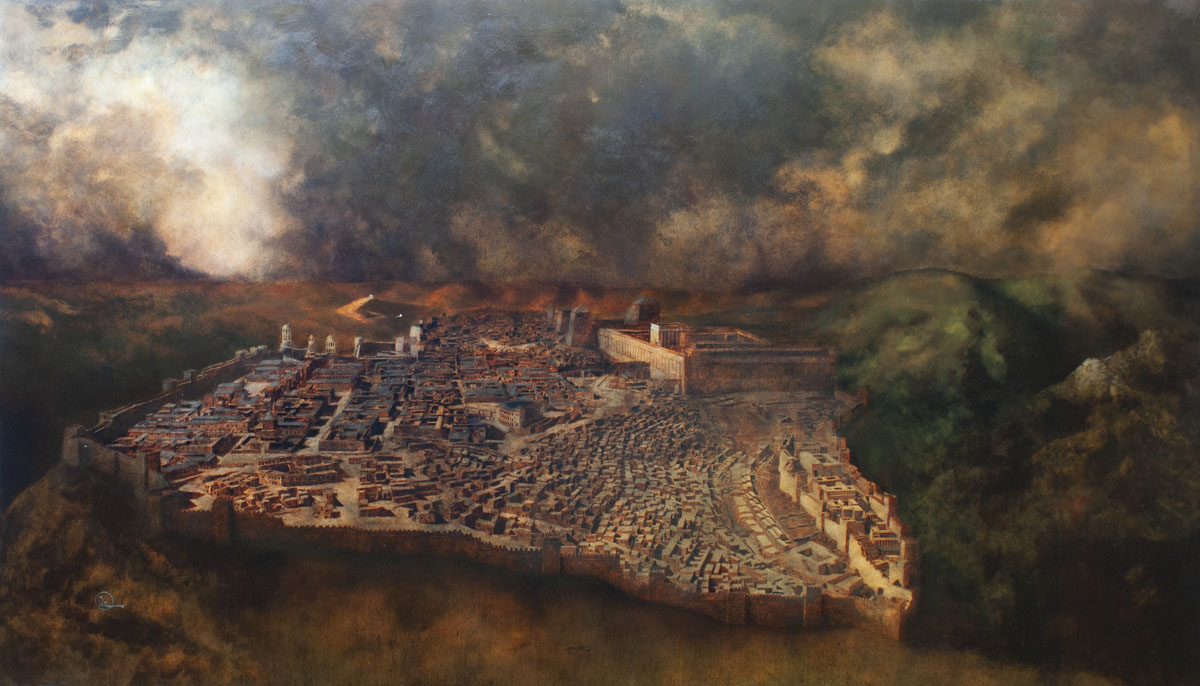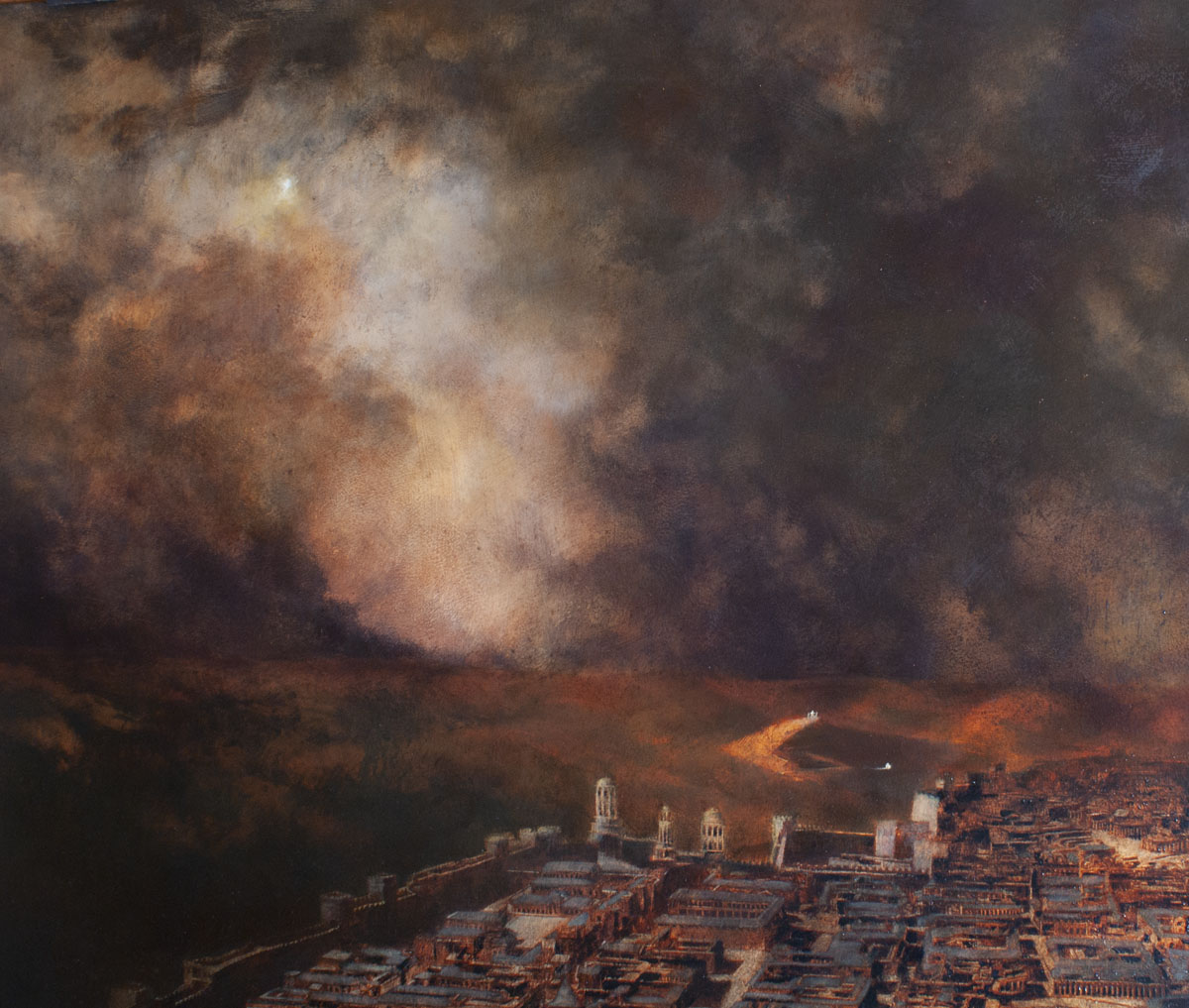Rending the Veil: The Path of Discipleship
By Al R. Young
 |
| Rending the Veil: The Path of Discipleship Copyright © by Al R. Young All Rights Reserved by Al R. Young, oil on panel, 2021 48 in. x 84 in. (HxW) |
Purchase the original artwork
Not for sale
Purchase open-edition print(s) of this artwork
No prints of this artwork are available
You will need the number of this artwork to request a license
Find out about the creation of this handmade artwork
Artist's commentary about the painting
Behold, when ye shall rend that veil of unbelief which doth cause you to remain in your awful state of wickedness, and hardness of heart, and blindness of mind, then shall the great and marvelous things which have been hid up from the foundation of the world from you—yea, when ye shall call upon the Father in my name, with a broken heart and a contrite spirit, then shall ye know that the Father hath remembered the covenant which he made unto your fathers, O house of Israel. (Ether 4:15)
And the sun was darkened, and the veil of the temple was rent in the midst. Luke 23:45Highlighted features in this painting (from left to right):
The ascension to Heaven of the resurrected Messiah
His resurrection from the garden tomb
His crucifixion on Golgotha
The rending of the veil of the temple in Jerusalem
The agony of the Messiah in Gethsemane, below the Mount of Olives
The darkness in the painting is the veil of unbelief, that shrouds not only a world, but can shroud any mind, any heart, any life. The rent in the sky signifies what the Messiah does for the world and for each individual associated with it. In other words, what He accomplished in the final hours of His mortal ministry was not a singular event, but is typical of what He can do for every living soul. In terms of physical death, for example, His resurrection gives everlasting life to all of us. The parting of the veil of unbelief, however, is something He does for anyone who wants Him to do so. While this painting celebrates some of the events during the culmination of the Savior's mortal ministry, it also presents the path of discipleship whereby the Redeemer opens the way not just to everlasting life, but life in the presence of the Father and the Son.
Discipleship begins in the darkness of unbelief because we are born into this fallen, darkened world (Moses 6:55). And, without discipleship, life transpires and ends in that same darkness. The city in this painting, like any great city, is filled with all the world has to offer: Wealth, power, fame, companionship, learning, luxury, etc. But notwithstanding the desirability of all these things, there is no way out from under the veil of darkness that separates the city and the rest of its world from Heaven.
The Mount of Olives (far right) is highlighted because Gethsemane was situated near the Mount. During the Savior' agony in Gethsemane, He suffered the pains and sins of all the children of God.
Golgotha is highlighted (far left) because there He suffered the most demonic kind of death ever devised. And during that agony He again suffered the aggregate burden of the pains and sins of all mankind (Jesus the Christ by James Talmage, p. 661, and The Purifying Power of Gethsemane, by Bruce McConkie, April 1985 General Conference of the Church of Jesus Christ of Latter-day Saints).
The tomb is highlighted because it was where death ceased to be a destination and became a doorway to life everlasting.
Along the path that included these three places (Gethsemane, Golgotha, and the tomb) the Messiah allowed darkness to empty its arsenal of hatred and destruction upon Him, doing everything darkness could imagine in order to torment and destroy the purposes of God. And by allowing darkness to have its way, the conclusion of the Savior's mortal ministry constitutes the single most complete revelation possible of the nature, objectives, and methods employed by darkness in its hatred of God and His children. Thus, in the Atonement of the Savior we see the fulness of the malevolence to which every temptation and every sin are connected. We see what the adversary wants to do to God and each of His children.
Finally, the temple is highlighted because the temple is and always has been the gate of Heaven. Its veil was rent in token of the Savior's victory over all that separates mankind from God. The light in this painting represents the hope and surety of the Holy One (upper left-hand corner of the painting), who is the Light and the Life and the Truth of the world. To be His disciple, is to do in all things as He did, not only for one's own sake, but for the sake of others.
 |
| This detail from the painting shows the Ascension (upper left), as well as the highlighting of the place of crucifixion (Golgotha, toward the lower righthand region of the painting and morth of the city), as well as the highlighting of the garden tomb (represented, here, as being near the base and toward the right of the mount of crucifixion). |
Tags: 2021, Oil paintings and prints
Browse articles by year: 2025 . 2024 . 2023 . 2022 . 2021 . 2020 . 2019 . 2018 . 2017 . 2016 . 2015 . 2014 . 2013 . 2012 . 2011 . 2010 . 2009 . 2008 . 2007 . 2006 . 2005 . 2004 . 2003 . 2002 . 2001 . 2000 . 1999 . 1998 . 1997 . 1996
Browse articles by topic: Art lessons . BenHaven Archives . Blank art diaries . Fine art photography . Framing . Illustration . Inspiration and creativity . Isles of Rune . Limited Editions Collection . My Fathers Captivity . News . Novellas . Oil paintings and prints . Operations announcements . Orders and shipping . Overview . Portfolios . The Papers of Seymore Wainscott . Project commentaries . Recipes by Nancy Young . Recommended reading . Recommended viewing . Temple artworks . The Storybook Home Journal . Tips and techniques . Tools supplies and operations
Browse articles by topic: Art lessons . BenHaven Archives . Blank art diaries . Fine art photography . Framing . Illustration . Inspiration and creativity . Isles of Rune . Limited Editions Collection . My Fathers Captivity . News . Novellas . Oil paintings and prints . Operations announcements . Orders and shipping . Overview . Portfolios . The Papers of Seymore Wainscott . Project commentaries . Recipes by Nancy Young . Recommended reading . Recommended viewing . Temple artworks . The Storybook Home Journal . Tips and techniques . Tools supplies and operations